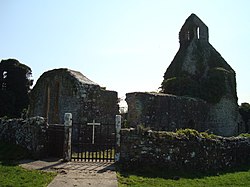Abbeyshrule Abbey
| Abbeyshrule Cistercian Abbey | |
|---|---|
 Abbeyshrule Abbey ruins |
|
| location |
County Longford |
| Coordinates: | 53 ° 35 ′ 6 ″ N , 7 ° 39 ′ 0 ″ W |
| Serial number according to Janauschek |
314 |
| founding year | 1150 |
| Year of dissolution / annulment |
1540 |
| Mother monastery | Mellifont Abbey |
| Primary Abbey | Clairvaux Monastery |
Abbeyshrule Abbey ( Irish Mainistir Shruthla ; Shrule; Flumen Dei; also given as Benedictio Dei) is a former Cistercian abbey in County Longford in what is now the Republic of Ireland . The monastery, which should not be confused with Shrule Abbey in County Mayo , is located in the parish Abbeyshrule on the banks of the River Inny about 7 km east-northeast of Ballymahon on the border with County Westmeath .
history
The monastery was founded in 1150 or 1200 on the site of an existing Christian settlement by the local chief family O'Ferral (O'Farrell), who are said to have controlled the abbey later. It was a daughter monastery donated by Mellifont Abbey and thus belonged to the Filiation of Clairvaux Primary Abbey . When Abbot Gilbert died in 1430, Kenan O'Ferral took possession of the abbey and had to be removed. The abbey had large estates west of Ballnamanagh but was never wealthy. The monastery was besieged twice, once by an army from the Pale (probably 1476) and again by Hugh Ruadh ODonnell. Monastery life probably ended at the latest in 1540, after the O'Ferral family had taken possession of the monastery goods, but the monastery was not formally dissolved until 1592 under Queen Elizabeth I.
Buildings and plant
The monastery church from the 13th century is quite well preserved, but the other convent buildings have been removed. A chapel was built into the presbytery in the 17th or early 18th century.
Originally there was also an approximately 1 m high cross on the monastery grounds , which is now kept in the sacristy of the Catholic Church of Abbeyshrule. A reproduction is at the entrance to the monastery grounds.
Around 30 m south of the church there is a post-Reformation " Tower House ".
Web links
- Site of the Certosa di Firenze to the monastery
- Website of Cistercians Sheffield (English)
- A Concise History of the Parish of Carrickedmond and Abbeyshrule, Co Longford, Ireland. ( Memento from December 12, 2010 in the Internet Archive )
- Website with a short historical overview and several photos ( memento from December 23, 2007 in the Internet Archive )
Individual evidence
- ↑ on the website of the Certosa di Firenze, but possibly confused with Kilbeggan Abbey (Benedicto Dei), which is called Flumen Dei there
- ^ The indication 1200 in Cistercians Sheffield